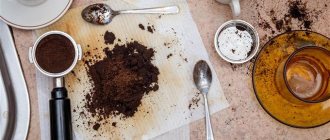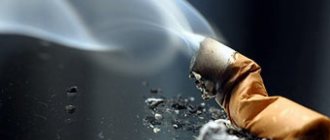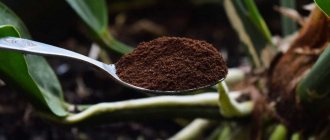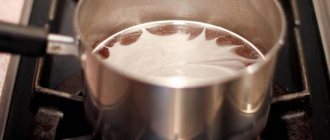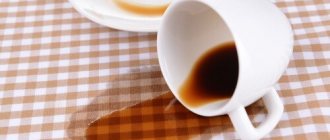Useful tips
Everyone knows that coffee
- This is a great way to wake up in the morning.
However, if you think that this drink is only good for this, you are mistaken.
Take a look at the following list of tips for using coffee grounds and you will see how versatile the ordinary coffee grounds that we usually throw in the trash can can be.
You can not only tell the future using coffee grounds.
How to use coffee grounds
1. Pest control
© Maciej Bledowski
Coffee grounds can be a great help in pest control
in your garden and garden.
Sprinkle used coffee grounds around your plants to protect them from destructive pests such as ants, snails and slugs.
And if you mix it with orange peel, then this mixture can keep small mammals - cats and dogs - at a distance.
If a mixture of coffee and orange zest doesn't work, try mixing it with rosemary oil.
Features of the use of coffee scrubs
Products based on green coffee have a stronger effect, but sometimes this can provoke an allergic reaction. For those who have never used homemade cosmetic scrubs made from coffee, you should first apply the freshly prepared mixture to the inner surface of the forearm (on the bend of the elbow), and after 15–20 minutes, wash it off.
In most cases, the skin will become red as coffee increases blood circulation. But if there is no allergy, then after half an hour the redness will disappear. Then you can apply the composition to the rest of the skin. If after half an hour the redness on the forearm remains, then it is better not to use the product.
The fresher the grounds, the better
“Safety precautions” when using coffee scrubs
- Cosmetics are prepared only from natural coffee: green or roasted. Adding instant or decaffeinated coffee to scrubs is pointless and sometimes harmful to the skin.
- You can prepare body scrubs from fine or medium-ground coffee: too large particles can damage the skin. The more sensitive and delicate it is, the finer the grind should be.
- It is not safe to apply scrubs made from medium-ground coffee to the face, neck and décolleté: scars from coffee beans are difficult to treat. Therefore, in scrubs intended for the face, neck and décolleté, only sleep coffee, ground into dust (for Turks), is added. Coffee ground in a home rotary coffee grinder should never be used in facial scrubs.
- The grains of the sleeping grounds are less sharp and hard than those of fresh ground coffee. Therefore, coffee is more suitable for sensitive skin. Arabica beans are softer than Robusta beans.
- If your skin is sensitive, you should not massage problem areas too intensely with a coffee body scrub.
- Fresh coffee has a weak coloring effect. On dark skin it is almost invisible: it seems that a very light tan has appeared on it. But such a “tan” is not even, and on white skin it looks like dirt stains. If this does not matter with anti-cellulite wraps (except for those cases when the next day after the procedure you need to go to the beach or pool), then dirty spots on the face look unaesthetic, and washing them with a pumice stone is very painful and harmful to the skin. For people with milky-white skin, it is better to use facial scrubs made from drunk coffee, and first be sure to check the coloring effect on the skin of the forearm.
Contraindications to the use of coffee scrubs
Coffee scrubs should not be applied to:
- on open ulcers, wounds, inflamed areas affected by acne, ulcers and boils. Penetrating under the skin, coffee extract can create a tattoo effect, leaving many dark spots;
- immediately after chickenpox, when the skin at the site of the rash has not yet healed properly.
Cake as fertilizer
2. Use as fertilizer for your garden
© ThamKC/Getty Images
If you grow azaleas, hydrangeas, rhododendrons, camellias, roses or other plants that like an acidic environment, then coffee grounds fertilizer
- This is what you need.
Mix coffee grounds with grass clippings, fallen brown leaves, or dry straw to
neutralize excess acidity.
Then the resulting mixture
spread around plants.
Used coffee grounds enrich the soil with nitrogen and potassium, and also increase magnesium, which all plants need to stay healthy.
How to use coffee grounds #7: Make your skin even softer
Coffee grounds aren't just good for your pets' skin and fur—they're great for people, too!
You can make a natural scrub from coffee grounds that will soften and brighten your skin. After washing, gently rub a handful of grounds into dry areas of your skin.
Just make sure it doesn't clog your sewer pipes!
Application of coffee grounds
3. As a compost fertilizer
© chiewr/Getty Images
If you are not using coffee as a primary fertilizer, you can put it in a compost bin for later use.
Coffee grounds will contribute to excellent “green” humus
because it is rich in nitrogen.
In addition, compost containing old coffee may attract beneficial worms. Just make sure that the resulting compost is proportionally balanced.
Excessive quantity
Added coffee grounds can cause the fertilizer to turn from
“green” to “brown”.
4. Caffeine for carrots
© Jimejume/Getty Images
Before sowing your carrot seeds, mix them with some dried coffee grounds to energize the seedlings from the start.
Thanks to this fertilizer, you will get a higher quality product in larger quantities. In addition, fertilizer in the form of coffee grounds will repel pests
, which pose a real threat to your future harvest.
5. As an odor absorber
© JackF/Getty Images
Coffee grounds can be used in the same way as baking soda to absorb food odors in the refrigerator and freezer.
Simply place a small, open container of coffee grounds toward the back of the refrigerator and leave for a couple of weeks. Coffee has the ability to absorb unpleasant odors from food.
During this time, you will be able to collect additional coffee grounds. Throw away the old cake or use it as fertilizer for your garden, and place the newly collected cake in a container in the same place.
6. Like natural sanding material
© JackF/Getty Images
Coffee grounds can be used as a cleaning agent for various surfaces
to remove dried food residue from kitchen furniture.
Used coffee grounds are a good abrasive material. However, it is not so hard as to scratch the surface.
If you use coffee grounds to scrub your kitchen surface, make sure that the granules do not get into any cracks, as they may leave behind stains.
7. Gold dye
© arinahabich/Getty Images
Each of us has spilled coffee on a shirt at least once in our lives and knows how corrosive the “coffee-golden” shade can be.
But this property of coffee can be used to your advantage.
Coffee cake will be an excellent and completely harmless dye.
, both for fabric and for Easter eggs.
How to use coffee grounds and leftover coffee: 8 options
You may have thought that you would drink a lot more prepared coffee than you actually did. Or maybe they got so caught up in their work that the cup that was brewed so carefully has now turned into a cold mess.
Don't waste that coffee. Why not reuse it? Once you know what to do with excess coffee grounds, you won't have to worry about where to put the leftovers - they can be very useful in some situations.
What to do with leftover coffee
We believe in measuring out the right amount of coffee so you don't have leftovers. And we're even bigger advocates of not wasting a good drink.
Let's look at the best ways to use leftover coffee instead of just pouring it down the drain.
Cook, bake and mix
Many recipes include coffee in their composition. Why not try one of them? If you already have extra coffee, you can make a delicious dessert using the grounds.
Of course, you're probably familiar with traditional coffee recipes like tiramisu with whipped cream and cocoa powder, but just use a little imagination and it will take you to new culinary heights.
Cooking with leftover coffee
Basically, that extra coffee you're trying to drink is just coffee-flavored water. It is better to use the leftover brewed drink when creating a marinade for steaks. When making fruit compote, try using grounds instead of water for the perfect finishing touch to your breakfast. You can even make your morning oatmeal with your coffee if you really want to be productive.
Coffee provides extra acidity no matter what you make. Experiment with vinaigrettes by replacing vinegar with leftover vinaigrettes. Create your own caffeinated chili or BBQ sauce. The possibilities are truly endless!
Using coffee as a water substitute for baking
You can use coffee instead of liquid when making desserts. Add it to cake or brownie water for a delicious, sweet treat. Then try flavored frosting for even tastier cupcakes and cookies.
Too early for sweets? Simply put the unfinished coffee in the refrigerator to use for baking in the evening. But don't leave it there for more than a day or two—you wouldn't want to bite into the cake and taste the old coffee, would you?
Create coffee ice cubes and smoothies
Don't like iced coffee because it defrosts before you drink it all?
Coffee ice cubes can fix that! Simply pour the remaining drink into a special container and freeze overnight. This way your iced coffee stays cold and undiluted! Try experimenting by making an iced coffee cocktail. Simply combine coffee ice cubes, bananas and milk or yogurt (one cup) for a cooling drink. You can even add a little cocoa powder, cinnamon, or vanilla to add extra flavor to your unique smoothie.
Ninja Blender, approximate cost: $49.99
Water the plants
The remaining coffee after brewing is useful outside the kitchen. If you grow plants that prefer acidic soil, such as azaleas or orchids, a cold, diluted drink can give them a good boost to vigorous growth. But since coffee is highly acidic, you should limit watering to one to two weeks.
Be sure to keep an eye on the plants. If they start to develop yellow or brown leaves, it is a sign that the soil has become too acidic. And, of course, do not use coffee to water plants if you have added cream, milk or sugar to the drink. Such components can attract pests and fungus.
Watering can for the home Novelty, volume – 4.5 liters. Approximate cost: $9.50
Develop your skills
We often worry about coffee stains, but what if we specifically tried to stain something with coffee?
If you're familiar with Instagram, you probably know what coffee art is. No, not latte art. We're talking about art that uses coffee as a paint. It's really cool and it's a cheap and non-toxic way to get kids creative. All you need is watercolor paper and a couple of brushes and you're good to go.
Textured watercolor paper Canson XL series, 23 by 30 centimeters, 30 sheets. Approximate cost: $9.97
What to do with used coffee grounds
You'd be surprised what people do with the leftovers of this drink. One company in the United Kingdom is processing coffee grounds to create bricks and biomass pellets for clean fuel. They are even considering producing biodiesel from coffee residues. Isn't that cool?
What we treat as trash has so much potential! However, you probably won't be producing the gas yourself, but you can use the mineral-rich grounds at home.
Fertilizer and compost
Even after brewing, the coffee is still loaded with minerals that benefit some plants.
Sprinkle coffee grounds directly onto your lawn for greener grass. It is recommended to sprinkle the flower bed with equal parts compost and soil to add slow-release nitrogen for the growth of healthier bushes and flowers. Leftover coffee grounds can even attract earthworms to the area. They play a key role in maintaining soil health.
Adding coffee residue to your compost bin is a convenient way to activate bacterial activity. A nitrogen-rich environment encourages the growth of microbes that feed the plants, although you may want to add some nitrogen fertilizer to make sure the microbes have a feed too.
Yimby Rotary Composter Approximate cost: $79.15
Homemade sponge
Coffee grounds are naturally large, but not so large as to scratch pots or pans. This is why it is suitable for cleaning utensils.
Rub the grounds into a rag, twist it so it doesn't unravel, and secure with an elastic band. All that remains is to start cleaning.
Getting rid of odors
Avoid storing coffee beans in the refrigerator - they absorb odors very well.
But once you have some leftover grounds, use them to eliminate bad odors in your refrigerator or freezer. This will be similar to using baking soda to deodorize your home. Odor absorber for refrigerators and freezers Chilly Mama. Approximate cost: $13.99
Safe disposal of medications
If you've been going through your medicine cabinet, you probably know not to throw old medications straight into the trash. Do you know why?
The main reason is the safety of children and animals. You've probably seen what a puppy or toddler does with an open trash can. Used coffee grounds help make disposal of old medications safer, especially if your area does not have a drug take-back program.
Remove the medication from the original container and mix it with the used coffee grounds in a sealed bag, empty jar, or other suitable container. This will make the drug less attractive to children and animals.
Coffee scrub
Recently, it has become popular to use a coffee scrub. There are many recipes and proportions, however, they all boil down to rubbing coffee grounds into the right place on your body, or not yours. You can offer it to your neighbor.
Don't throw away your coffee
As you now know, you can do more with used grounds than just throw them in the trash or pour them down the drain.
Therefore, do not give up the chance to extend the life of coffee by adding it to food, fertilizing plants with it, or doing cleaning with it.
Happy caffeination!
Coffee body scrub
9. Exfoliate your skin
© Javier Sánchez Mingorance
Coffee leftovers make an excellent body scrub.
. Just add a small amount of warm water and your favorite oil to the cake (for example, coconut oil is great for this purpose).
Just 5 minutes, a couple of ingredients - and you have an excellent body scrub. Use this product literally from head to toe to remove dead skin cells.
Home use of coffee leftovers
You can use your coffee grounds at home to fertilize your soil before planting your houseplants or adding them to your compost pile.
You can also use coffee waste for cosmetic purposes, for example, use a homemade coffee-based scrub instead of expensive cosmetic scrubs and body peels. To do this, combine a teaspoon of olive or almond oil, a tablespoon of honey and coffee grounds. Apply to body using a small amount of shower gel. Massage and rinse thoroughly.
Coffee residue is a great way to clean pots and other kitchen utensils. Coffee has an abrasive property and will easily wash away grease and old stains.
The smell of coffee repels animals and insects. You can take advantage of this when fighting mosquitoes by simply placing some coffee in the room. Using coffee as a shampoo will help rid your pet of fleas.
A paste of coffee grounds and water will renew wooden furniture and mask scratches.
Placed coffee beans on a shelf in your closet will give your things your favorite aroma.
As a marinade for meat, coffee will add a unique and piquant taste to the dish.
Other uses of coffee waste, such as biodiesel production, require significant scale-up processes and implementations.
Coffee face scrub
10. Facial scrub
© MishaBeliy/Getty Images
Using the same principle, coffee grounds work as a facial scrub.
.
Mix two tablespoons of coffee grounds with an equal amount of organic cocoa powder. Add three tablespoons of whole milk or heavy cream and finish the mixture with a tablespoon of honey.
The perfect facial scrub, containing beneficial minerals and natural antioxidants, is ready.
11. Coffee for hair
© MilanMarkovic / Getty Images Pro
If you use hair styling products frequently and heavily, or you've recently switched to a natural, silicone-free shampoo and conditioner, your hair is probably in need of a lift.
Used coffee grounds will give your hair extra volume and help restore its natural and healthy shine.
How to use coffee grounds #8: Get rid of dark circles under your eyes
Coffee helps with dark circles under the eyes - but not only when you drink it!
After all, caffeine, as well as some other substances contained in the thickener, tighten and lighten the skin.
Mix coffee grounds with a little olive oil to make a moisturizing paste and apply gently under the eyes, then rinse off after 5-10 minutes.
To achieve the effect, repeat the procedure about twice a week.
Use as fertilizer in the garden
Coffee grounds contain many valuable substances for plants and can be used in gardening. According to experts, it is rich in nitrogen, calcium, iron, phosphorus, magnesium, potassium and chromium.
It has also been proven that “coffee concentrate” absorbs a wide range of heavy metals and other toxic substances from the soil that can pollute the soil and be extremely toxic to the human body.
Coffee grounds attract worms, which loosen the soil and make it more suitable for growing any crops.
To realize all the described effects, you just need to evenly sprinkle the remaining coffee on the ground around the plants.
Coffee grounds are a valuable fertilizer in the garden at the dacha or in a private home, which supports plant growth, neutralizes a number of harmful substances in the soil and attracts worms.
Make scrub soap
Due to their structure, coffee beans are excellent for mechanically removing impurities from the skin (paint stains, grass juice, etc.), dry flaky areas. To do this, not only use the grounds in their pure form, but also make a mix with several components to get a scrub soap.
Recipe:
- Melt 225g of pure, additive-free soap using a water bath. Another option is the microwave: the soap is “cooked” by removing it every 20–30 seconds and stirring. Power is selected from 50 to 80%, depending on the maximum. The mass should not boil.
- Mix 5 tbsp. l. bentonite clay (or plain black) with the same amount of warm water to form a paste. Add to cooled soap.
- Add 5 tbsp. l. coffee grounds, the same amount of shea butter, 1 tbsp. l. corn flour. If desired, stir in 1 tsp. lemon essential oil.
- Allow the mixture to harden in shape at room temperature and use as directed.
Getting rid of insects and pests
Coffee contains a number of compounds that scientists have found may be toxic to insects. These include: caffeine and diterpenes.
Coffee grounds also potentiate the effect of pesticides used in household and industrial crop cultivation.
Foreign experts have found that coffee (due to its color and smell) is attractive to many mosquitoes, fruit flies and beetles. When consuming such a product, insects usually die.
In order to limit the number of pests, you can place cups of coffee in crowded places or treat the ground around the plants with coffee grounds (within a radius of 5-15 cm).
Thus, coffee grounds can be used to reduce the number of insects and garden pests.
Properties of the constituent components
Some gardeners use dried coffee cake as a natural fertilizer for areas with alkaline soil. Before scientific research, it was believed that due to the high level of acidity, dried grounds were added only when growing flowers.
In practice, it turned out that the natural coffee product has a neutral pH level. Thanks to this, its use in gardening is justified when it is necessary to enrich the soil with useful elements. Both experienced and novice gardeners know this.
It is important to note that coffee is used due to its valuable composition. It contains: Ca, Mg, P, N, K
According to research, the amount of the above microelements is about 3%. This indicator is not bad when adding coffee as a fertilizer for the garden.
The valuable element phosphorus (P) together with potassium (K) promote harmonious plant growth, beautiful flowering and rapid fruit formation. The trace elements nitrogen (N) and magnesium (Mg) take an active part in photosynthesis, which improves the growth of plants and vegetable crops. Coffee grounds as a fertilizer will be an ideal free fertilizer, the regular use of which will help you get a rich harvest.
Seedlings grown on the windowsill are planted in specially prepared holes, which contain the dried coffee pulp. In gardening, a natural additive will not only improve the growth and development of flowers, but with its tart smell it will not attract harmful insects. Ants and slugs living in the soil cannot tolerate this aroma.
To get rid of annoying wasps and flies on hot summer days, it is recommended to set fire to a small amount of dried grounds from ground coffee.
Spent coffee is like fertilizer. Use of coffee grounds in gardening
Freshly brewed coffee invigorates a person, and properly prepared cake stimulates life processes in plants. Can coffee grounds be used as fertilizer? Yes! Experienced gardeners use grounds when planting crops in open ground at the dacha. Coffee grounds work well on plants placed in rooms, greenhouses, and greenhouses. Particularly effective for crops that lack nitrogen.
The cake can be used:
- diluted in water and powder form;
- as a single-component fertilizer and as part of a complex additive.
Dried coffee as a fertilizer is an excellent feeding for ornamental, fruit and vegetable crops. Grains contain:
- vitamins (B6, B2, PP);
- nitrogenous (13.9%) and mineral (3.9%) substances: calcium, potassium, manganese, nitrogen, phosphorus.
The grounds that remain after boiling the crushed grain are suitable for use. Due to the high acid content, the use of ground but not thermally treated coffee is harmful to plants. To fertilize crops, only the sediment that has settled at the bottom of the coffee maker or turk is used. The liquid extract is drained and filtered through a strainer.
For which plants is coffee fertilizer suitable?
And yet, sleeping coffee is a top dressing that is not suitable for every plant. Therefore, before you widely use it in your garden, you need to study for which plants it is most effective to use coffee grounds as a fertilizer. It is most useful for flowers that prefer low pH levels - azaleas, hydrangeas, heathers and rhododendrons. Due to the large amount of potassium in the composition, coffee grounds can be used as a fertilizer when growing vegetable crops, such as tomatoes, potatoes, cucumbers, and peppers. Feeding fruit trees with dormant coffee will also help to significantly increase their fruiting. Magnesium contained in coffee is beneficial for berry bushes. Magnesium and potassium will help you get a high yield of root crops, while nitrogen is indispensable for green crops.
Among house plants, roses, palm trees, ficuses and ferns, as well as violets and asparagus respond best to coffee fertilizing. When using coffee grounds as fertilizer for indoor plants, it is recommended to first drain and dry them. If you simply pour the remains of coffee from a cup into the pot, most likely there will be no benefit, but on the contrary, the soil may become crusty and begin to mold. To prevent this, you need to mix the prepared grounds with soil suitable for this type of plant.
Coffee with sugar or milk should not be used to feed garden, vegetable and flower crops, since sugar attracts ants, and milk provokes the development of putrefactive processes in the soil, which can harm the root system of plants.
